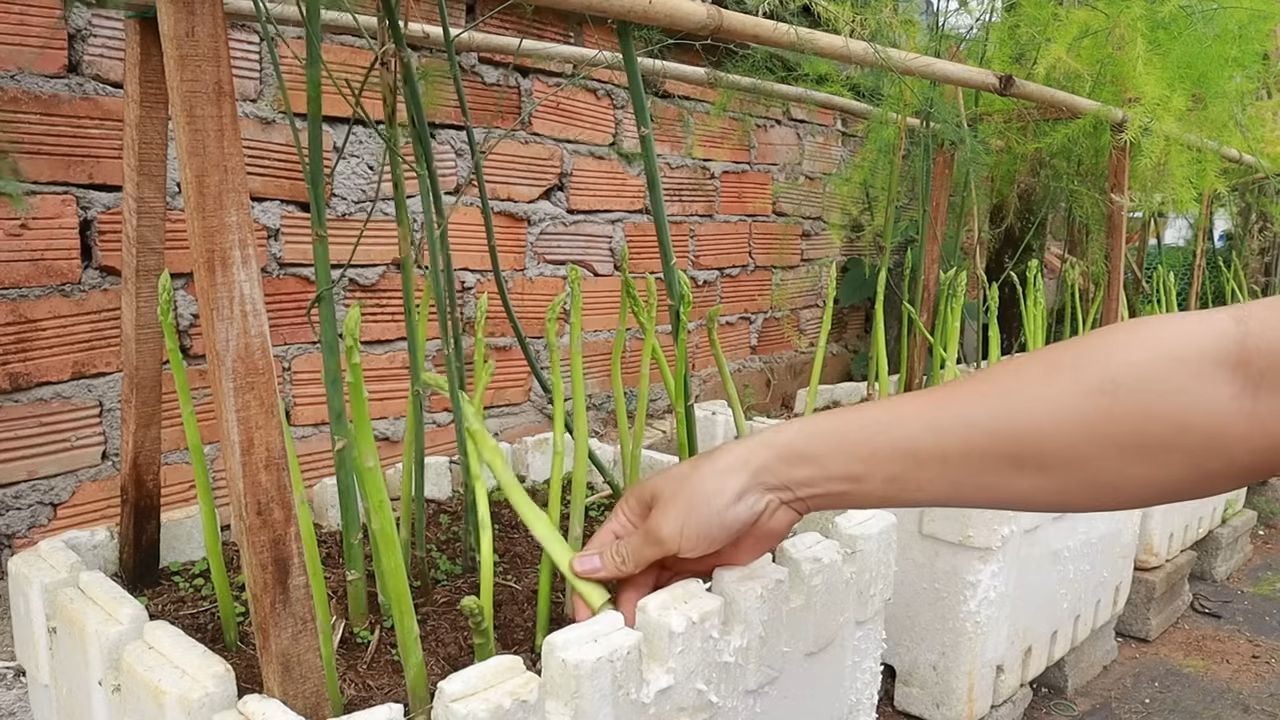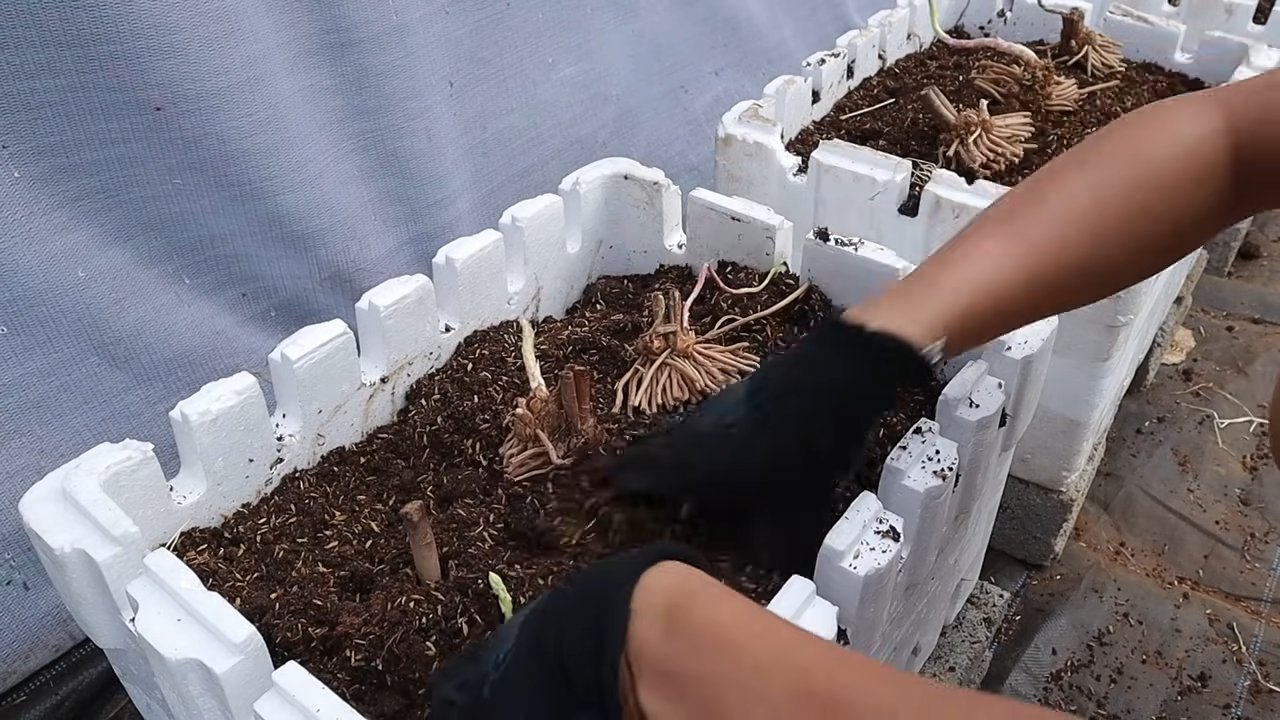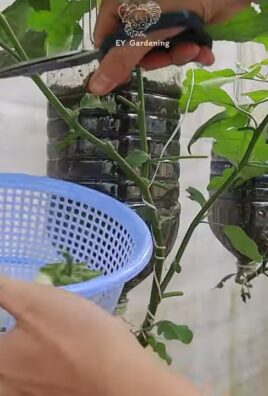Grow Asparagus Quickly and unlock the secrets to a thriving, delicious harvest right in your own backyard! Have you ever dreamed of snipping fresh, tender asparagus spears just moments before adding them to your favorite dish? It’s more achievable than you think, and this DIY guide is your key to making that dream a reality. For centuries, asparagus has been prized for its delicate flavor and nutritional benefits, enjoyed by ancient Romans and gracing the tables of royalty.
But let’s be honest, waiting years for your asparagus plants to mature can feel like an eternity. That’s where these clever tricks and hacks come in! I’m going to share my tried-and-true methods to help you grow asparagus quickly, bypassing the typical lengthy wait and maximizing your yield. Whether you’re a seasoned gardener or just starting out, these tips will empower you to cultivate a bountiful asparagus patch in record time.
Imagine the satisfaction of serving homegrown asparagus to your family and friends, knowing you nurtured it from sprout to spear. This guide is designed to demystify the process, providing you with practical, easy-to-follow instructions that will have you harvesting delicious asparagus sooner than you ever thought possible. So, grab your gardening gloves, and let’s get started!

Growing Asparagus Faster: A DIY Guide
Asparagus, that delicious and nutritious spring vegetable, is notorious for its slow growth. Traditionally, you plant asparagus crowns and wait a whopping two to three years before harvesting. But what if I told you there’s a way to speed things up? While you can’t completely bypass the waiting game, this guide will show you how to significantly accelerate asparagus growth and potentially harvest sooner than you think! This method focuses on creating the optimal environment for your asparagus to thrive, leading to faster root development and stronger, more productive plants.
Understanding Asparagus Growth
Before we dive into the DIY hack, let’s quickly understand how asparagus grows. Asparagus is a perennial plant, meaning it lives for many years. The edible spears we harvest are actually the young shoots emerging from the underground crown. The crown is a mass of roots and buds that stores energy for the plant. The first year or two after planting, the plant focuses on establishing a strong root system. Harvesting too early can weaken the plant and reduce its long-term productivity. Our goal is to encourage rapid root development so the plant can mature faster.
The DIY Hack: Supercharging Asparagus Growth
This method combines several techniques to create the ideal growing conditions for asparagus. We’ll focus on soil preparation, planting techniques, and ongoing care to maximize growth.
Materials You’ll Need:
* Asparagus crowns (1-year-old crowns are ideal)
* Well-rotted compost
* Aged manure (optional, but highly recommended)
* Bone meal or rock phosphate
* All-purpose organic fertilizer (slow-release)
* pH testing kit
* Garden fork or shovel
* Measuring tape
* Watering can or hose
* Mulch (straw, wood chips, or shredded leaves)
* Optional: Raised garden bed materials (if you prefer raised beds)
Phase 1: Soil Preparation – The Foundation for Success
Asparagus needs well-drained, fertile soil with a slightly acidic to neutral pH (6.0-7.0). Proper soil preparation is crucial for healthy root development.
1. Choose Your Location: Select a sunny spot in your garden that receives at least 6-8 hours of direct sunlight per day. Asparagus is a sun-loving plant! Make sure the location is well-drained; asparagus roots don’t like to sit in soggy soil.
2. Test Your Soil’s pH: Use a pH testing kit to determine the pH of your soil. If your soil is too acidic (below 6.0), amend it with lime. If it’s too alkaline (above 7.0), add sulfur. Follow the instructions on the pH testing kit and amendment product for proper application rates.
3. Dig a Trench: Dig a trench that is approximately 12 inches wide and 6-8 inches deep. The length of the trench will depend on how many asparagus crowns you’re planting. Space the crowns about 12-18 inches apart.
4. Amend the Soil: This is where the magic happens! Mix the soil you removed from the trench with generous amounts of well-rotted compost and aged manure (if using). Aim for a 50/50 mix of soil and organic matter. This will provide essential nutrients and improve drainage.
5. Add Bone Meal or Rock Phosphate: Incorporate bone meal or rock phosphate into the soil mixture. These are excellent sources of phosphorus, which is crucial for root development. Follow the instructions on the product label for application rates.
6. Fill the Trench Partially: Fill the trench with the amended soil mixture to a depth of about 4 inches. This will create a raised bed for the asparagus crowns to sit on.
Phase 2: Planting the Asparagus Crowns – Giving Them a Head Start
Proper planting is essential for establishing healthy asparagus plants.
1. Soak the Crowns (Optional): Before planting, you can soak the asparagus crowns in water for about an hour. This will help rehydrate them and give them a boost.
2. Position the Crowns: Place the asparagus crowns in the trench, spacing them 12-18 inches apart. The buds (the small, pointy growths) should be facing upwards. Gently spread the roots out around the crown.
3. Cover the Crowns: Cover the crowns with about 2 inches of the amended soil mixture. Don’t bury them too deep initially. As the spears grow, you’ll gradually add more soil.
4. Water Thoroughly: Water the newly planted crowns thoroughly to settle the soil and provide moisture.
Phase 3: Ongoing Care – Nurturing Growth
Consistent care is key to accelerating asparagus growth.
1. Water Regularly: Asparagus needs consistent moisture, especially during the first year. Water deeply whenever the soil feels dry to the touch. Avoid overwatering, as this can lead to root rot.
2. Fertilize Regularly: Apply a slow-release organic fertilizer every spring. This will provide the plants with the nutrients they need to grow and produce spears. Follow the instructions on the fertilizer label for application rates. You can also side-dress with compost throughout the growing season.
3. Weed Control: Keep the asparagus bed free of weeds. Weeds compete with the asparagus for nutrients and water. Hand-pull weeds regularly or use a hoe to cultivate the soil. Be careful not to damage the asparagus roots.
4. Mulch: Apply a layer of mulch around the asparagus plants. Mulch helps retain moisture, suppress weeds, and regulate soil temperature. Use straw, wood chips, or shredded leaves as mulch.
5. Gradually Fill the Trench: As the asparagus spears grow, gradually add more of the amended soil mixture to the trench. This will encourage the development of more roots and support the growing plants. Continue adding soil until the trench is completely filled.
6. Fern Management: After the harvest season (usually in late spring or early summer), allow the asparagus plants to fern out. The ferns are the leafy growth that develops after the spears are harvested. The ferns are essential for photosynthesis and storing energy for the next year’s growth.
7. Cut Back the Ferns: In late fall or early winter, after the ferns have turned brown and died back, cut them back to the ground. This will help prevent disease and pests from overwintering in the asparagus bed.
8. Pest and Disease Control: Monitor your asparagus plants for pests and diseases. Common asparagus pests include asparagus beetles and aphids. Common diseases include asparagus rust and fusarium crown rot. Take appropriate measures to control pests and diseases if they occur. Organic pest control methods include using insecticidal soap or neem oil. For diseases, ensure good air circulation and avoid overwatering.
9. Patience is Key (But Less Than Usual!): While this method aims to accelerate growth, remember that asparagus still needs time to mature. Resist the urge to harvest too early. In the first year, don’t harvest any spears. In the second year, you can harvest a few spears for a short period (about 2 weeks). In the third year, you can harvest for a longer period (about 4-6 weeks). After that, you can harvest for the full season (about 8-10 weeks).
Harvesting Your Asparagus
When the spears are about 6-8 inches tall and the tips are still tightly closed, they’re ready to harvest. Snap or cut the spears off at ground level. Avoid damaging the surrounding spears or the crown.
Why This Works: The Science Behind the Speed
This DIY hack works by providing the asparagus plants with the optimal conditions for growth. The well-drained, fertile soil encourages rapid root development. The regular watering and fertilization provide the plants with the nutrients and moisture they need to thrive. The mulch helps retain moisture, suppress weeds, and regulate soil temperature. By following these steps, you can significantly accelerate asparagus growth and potentially harvest sooner than you think.
Troubleshooting
* Yellowing Spears: This could indicate overwatering, nutrient deficiency, or disease. Check the soil moisture and adjust your watering accordingly. Fertilize with a balanced organic fertilizer. Inspect the plants for signs of disease.
* Thin Spears: This could indicate nutrient deficiency or overcrowding. Fertilize with a balanced organic fertilizer. If the plants are overcrowded, thin them out by removing some of the crowns.
* No Spears: This could indicate that the plants are not getting enough sunlight, water, or nutrients. Ensure the plants are receiving at least 6-8 hours of direct sunlight per day. Water regularly and fertilize with a balanced organic fertilizer.
Final Thoughts
Growing asparagus can be a rewarding experience. While it requires patience, this DIY hack can help you enjoy fresh, homegrown asparagus sooner than you might think. Remember to provide your asparagus plants with the optimal conditions for growth, and they will reward you with delicious spears for many years to come! Happy gardening!

Conclusion
So, there you have it! Mastering the art of how to grow asparagus quickly is not just a gardener’s dream; it’s an achievable reality with a little planning and the right techniques. We’ve explored the key elements that contribute to accelerated asparagus growth, from selecting the right variety and preparing the soil meticulously to providing optimal watering and fertilization. Remember, patience is a virtue, but with these methods, you’ll be harvesting those delicious spears much sooner than you might have thought possible.
This DIY trick isn’t just about speed; it’s about maximizing the health and productivity of your asparagus patch. By focusing on soil quality, proper drainage, and consistent care, you’re setting the stage for years of bountiful harvests. Think of it as an investment in your future culinary adventures! Imagine the satisfaction of serving freshly picked asparagus, knowing you nurtured it from the ground up.
But don’t stop there! Experiment with different variations to tailor the process to your specific climate and soil conditions. For instance, if you live in a particularly cold region, consider using raised beds or cold frames to provide extra protection during the early stages of growth. If your soil is naturally acidic, amend it with lime to achieve the ideal pH level. You could also try different companion planting strategies, such as planting basil or tomatoes near your asparagus to deter pests.
Consider exploring different asparagus varieties beyond the standard ‘Jersey Knight.’ ‘Purple Passion’ offers a sweeter flavor and a beautiful visual appeal, while ‘Millennium’ is known for its high yields and disease resistance. Each variety has its unique characteristics, so research and choose the one that best suits your taste and growing conditions.
Furthermore, don’t underestimate the power of observation. Regularly inspect your asparagus plants for signs of pests or diseases. Early detection is crucial for preventing widespread problems and ensuring a healthy harvest. Keep an eye out for asparagus beetles, aphids, and fungal diseases, and take appropriate action if you spot any issues.
We’ve also touched upon the importance of proper harvesting techniques. Remember to snap off the spears at ground level when they reach the desired size, typically around 6-8 inches tall. Avoid cutting the spears, as this can damage the crown and reduce future yields. And be sure to leave some spears to fern out, as this allows the plant to replenish its energy reserves for the following season.
Ultimately, the success of your asparagus growing endeavor depends on your dedication and willingness to learn. Don’t be afraid to experiment, make mistakes, and adapt your approach as needed. Gardening is a journey, and every season brings new challenges and opportunities.
So, what are you waiting for? Grab your gardening gloves, prepare your soil, and embark on this exciting adventure of growing your own asparagus quickly. We’re confident that you’ll be amazed by the results. And most importantly, don’t forget to share your experiences with us! We’d love to hear about your successes, challenges, and any unique tips or tricks you discover along the way. Share your photos and stories on social media using #GrowAsparagusQuickly, and let’s inspire others to join the asparagus-growing revolution! Happy gardening!
Frequently Asked Questions (FAQ)
1. How long does it really take to grow asparagus from seed?
Growing asparagus from seed is a longer process compared to using crowns. It typically takes about three years to harvest asparagus spears when starting from seed. The first year is dedicated to establishing strong roots and foliage. The second year focuses on further root development. By the third year, you can usually begin harvesting a small crop. Using crowns, on the other hand, can shorten this timeframe by a year or more, as the crowns are already established plants. However, starting from seed can be more economical and allows you to select specific varieties that may not be readily available as crowns.
2. What is the best soil pH for growing asparagus?
Asparagus thrives in slightly alkaline soil with a pH between 6.5 and 7.5. Soil testing is crucial to determine your soil’s current pH level. If your soil is too acidic (below 6.5), you can amend it with lime to raise the pH. Follow the instructions on the lime product for the appropriate application rate. If your soil is already alkaline (above 7.5), you can add sulfur or organic matter to lower the pH. Maintaining the correct pH level is essential for nutrient availability and optimal asparagus growth.
3. How often should I water my asparagus plants?
Asparagus needs consistent moisture, especially during the growing season. Water deeply and regularly, aiming for about 1-2 inches of water per week. Avoid overwatering, as this can lead to root rot. The best way to determine if your asparagus needs watering is to check the soil moisture. Stick your finger into the soil about an inch deep. If the soil feels dry, it’s time to water. During dry spells, you may need to water more frequently. Mulching around the plants can help retain moisture and reduce the need for frequent watering.
4. What kind of fertilizer should I use for asparagus?
Asparagus benefits from regular fertilization to support healthy growth and abundant harvests. A balanced fertilizer with an NPK ratio of 10-10-10 or 10-20-10 is a good choice. Apply fertilizer in early spring before the spears emerge and again after the harvest season. You can also use organic fertilizers such as compost, aged manure, or bone meal. These organic options provide nutrients slowly and improve soil health. Avoid over-fertilizing, as this can damage the plants. Follow the instructions on the fertilizer product for the appropriate application rate.
5. How do I deal with asparagus beetles?
Asparagus beetles are a common pest that can damage asparagus plants. They feed on the spears and foliage, causing stunted growth and reduced yields. Handpicking the beetles and their larvae is an effective way to control small infestations. You can also use insecticidal soap or neem oil to spray the plants. These organic options are less harmful to beneficial insects. Regularly inspect your plants for signs of asparagus beetles and take action promptly to prevent widespread damage. Crop rotation and companion planting can also help deter asparagus beetles.
6. Can I grow asparagus in containers?
Yes, you can grow asparagus in containers, but it requires a large container and careful attention to watering and fertilization. Choose a container that is at least 18 inches deep and wide to accommodate the asparagus roots. Use a well-draining potting mix and ensure the container has drainage holes. Water regularly and fertilize as needed. Container-grown asparagus may not produce as abundantly as plants grown in the ground, but it’s a viable option for gardeners with limited space.
7. How do I know when to stop harvesting asparagus?
It’s important to stop harvesting asparagus spears after about 6-8 weeks to allow the plants to replenish their energy reserves for the following season. Continuing to harvest beyond this point can weaken the plants and reduce future yields. Once you stop harvesting, allow the remaining spears to fern out. The ferns will photosynthesize and store energy in the roots, ensuring a healthy and productive crop next year.
8. What are some good companion plants for asparagus?
Companion planting can benefit asparagus by deterring pests, attracting beneficial insects, and improving soil health. Some good companion plants for asparagus include tomatoes, basil, parsley, marigolds, and nasturtiums. Tomatoes and basil can help repel asparagus beetles, while marigolds and nasturtiums can attract beneficial insects that prey on pests. Parsley can improve soil drainage and aeration. Avoid planting asparagus near onions, garlic, or other alliums, as they can inhibit asparagus growth.
9. How do I overwinter asparagus plants?
Asparagus plants are perennial and can survive cold winters with proper care. After the ferns have turned brown in the fall, cut them back to about 2 inches above the ground. Apply a layer of mulch, such as straw or compost, to protect the roots from freezing temperatures. In colder climates, you may need to provide additional protection, such as covering the plants with a cold frame or burlap. Remove the mulch in early spring to allow the new spears to emerge.
10. Is it possible to grow asparagus in shade?
Asparagus prefers full sun, which means at least 6-8 hours of direct sunlight per day. While it can tolerate some shade, it will not produce as abundantly in shady conditions. If you live in a hot climate, some afternoon shade can be beneficial to prevent the plants from overheating. However, avoid planting asparagus in areas that receive mostly shade, as this will result in weak growth and reduced yields.





Leave a Comment